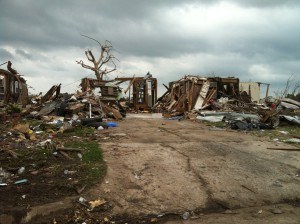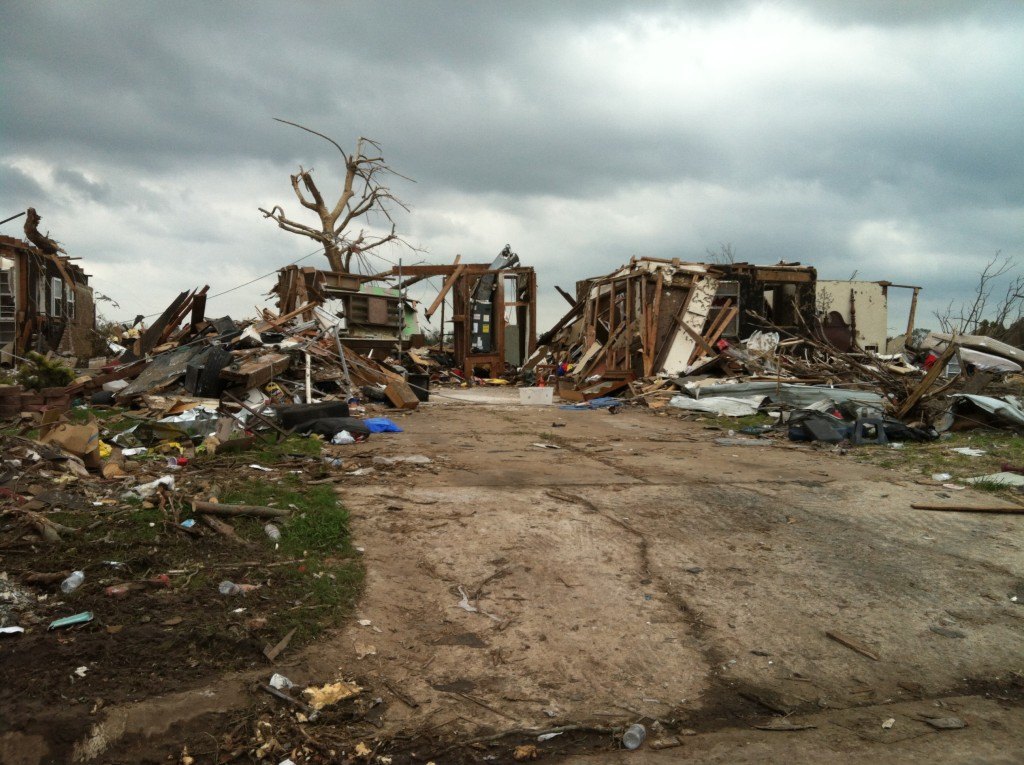When the big twister hit, Maylene Sorrels huddled with her students in the halls of Plaza Towers Elementary School in Moore, Okla.
Cowering, she covered the student’s heads. Then Sorrels, a teacher’s aide, tried to reassure her kids they would be okay. And even though she heard them cry and sob, that sound, she said, was reassuring.
When the big twister hit, Maylene Sorrels huddled with her students in the halls of Plaza Towers Elementary School in Moore, Okla.
Cowering, she covered the student’s heads. Then Sorrels, a teacher’s aide, tried to reassure her kids they would be okay. And even though she heard them cry and sob, that sound, she said, was reassuring.
“Right after the storm hit it, it got really quiet,” Sorrels said. “That was scary. Then I heard the kids sob and cry and I knew they were alive – because they were making noise.”
A single mother with eight children, Sorrels said she didn’t mind the tears, even as pieces of the ceiling fell around her.
“Everything was falling on top of us, but we just kept our heads down,” she said. “I prayed as loud as I could that God would help us and keep us safe.”
Maylene Sorrels was lucky.
Neither she, nor her eight children (who were also students in the Moore district), were seriously injured by the EF-5 twister. The storm ravaged a good chunk of the south Oklahoma City suburb of Moore. The storm destroyed more than 1,100 homes and killed 24 people – including seven Plaza Towers students.

Eleven days later, on May 31, Maylene and her family would ride out another wave of twisters that would scar central Oklahoma, killing another eight people and causing millions more in damage.
Still though she counts herself blessed, the road to normalcy continues to be a long and difficult path for Maylene, her family and thousands of other Oklahomans who continue to try and put their lives back together.
Mounting Claims
Now, the sirens are quiet. The emergency responders have moved on and the parking lot of Moore’s First Baptist Church – which served as a staging area for insurance industry professionals, emergency responders and other disaster services – has only cars.
The twisters of May 2013 are now a memory.
Across Moore and south Oklahoma City, debris is being removed, belongings catalogued and thousands of residents whose lives were disrupted have moved into the rebuilding process.
But recovery – even for those with homeowners, auto insurance and emergency disaster resources – won’t come easy.

Some damage estimates put the total well above the $2 billion mark. On June 18, Oklahoma Insurance Commissioner John Doak issued a statement that reported 70,782 insurance claims have, so far, been filed. Insurance payments, the commissioner said, had reached more than $561 million.
“These numbers are more proof of the dramatic impact the tornadoes had on our state,” Doak said. “Thousands of Oklahomans are now in the process of rebuilding their lives. Insurance can help them do that and I am glad to see that so many of the victims were insured.”
Data from Doak’s office shows that homeowners filed more than 17,000 claims for the May 19 and 20 storms with payments totaling $374,144,234. Commercial property owners filed 993 claims with payments totaling more than $18 million.
In addition, Oklahomans filed 21,218 private automobile insurance claims after the first tornado hit. Payments have reached $61,427,445.
The May 30 and 31 storms hit residents – and their insurance companies – with a second hammer. According to Doak, homeowners’ claims from the second round of twisters have topped 16,000 with payments totaling $62,945,489.
Private auto claims totaled 10,475 for the second storms with $19,067,584 being paid. The second round of twisters also sparked 1,557 commercial property claims and 306 commercial auto claims. Payments on both have reached the $3 million level.
Navigating the System
Yet even though their homes were insured, for families such as the Sorrels, navigating the insurance system is difficult, at best. Though Sorrels’ four-bedroom home was in the direct path of the May 20 twister, the home wasn’t completely destroyed.
And, in an ironic sense, that’s the problem.
Because the structure wasn’t leveled, Sorrels said she was told her house may be salvageable – but her insurance may not cover the complete cost to rebuild.
“The structure is still standing,” she said. “But everything is pretty much gone. We did have insurance, but we’re not sure what they are going to do. I met with an adjuster, but the house wasn’t totaled.”
Her home, Sorrels said, has extensive interior, foundation and water damage.
“All the sheetrock, everything on the inside, has to come out,” she said. “It got hit by water and debris that came through the room.”
Sorrels said several Oklahoma contractors have told her the structure should be condemned.
“The construction guys say they won’t repair it because it is totaled and the insurance guys say it can be repaired,” she said. “While all that’s going on, I’m living in a hotel with eight children – the whole thing has turned my world upside down. It’s very frustrating.”
Damage Upon Damage
Sorrels isn’t alone. Across Moore, the home Christy Howez and her fiancé, Leland Gross and Gross’ daughter shared remains standing – despite extensive water damage and the fact a car was hurled against the bedroom wall of the house.
And like Sorrels, Howez said the house – located off Eastern in Moore, wasn’t damaged enough to recover the full cost of construction. Her home, Howez said, is caught in between the lines of fine print.
“We’re the first standing house on the block where it (the twister) went through,” she said. “If you look at our neighbor’s house – which is one wall and half a room – and our house which is all four walls and almost a complete roof, comparatively our house looks great.”
Gross’ car, a late model Malibu was totaled.
“We thought, ‘oh the tornado didn’t do as much damage as it did to our neighbors,’” she said. “And then the rains came.”
After the rain, the damage was even worse.
“There was standing water in several rooms, and every room in the house had ceilings, sagging, waiting to collapse,” she said.
Several days later, a claims adjuster examined the property. Howez said the adjuster told her the house was salvageable.
But an inspector for the construction company the couple hired to repair the house said his company “wouldn’t touch it” because the structure was too heavily damaged.
“They won’t do anything because he (the construction inspector) thinks it should be totaled,” she said.
Then the looters came.
Across southern Oklahoma County and in the damage belt, thieves have preyed on the victims of the storm. Howez said thieves tried to get in through a back window at her home, but were unsuccessful.
“Had they been successful, they probably would have had a pretty big payday,” she said.
Law enforcement officials made several arrests, but the incident, Howez said, left her frightened.
“It’s pretty awful when you have to fight nature and then someone wants to take what you have left,” she said.
Rising Frustration
For both women, the elation of surviving two life-threatening storms with their families unharmed has been replaced by frustration with insurance policies, endless meetings with adjusters and contractors, life in a hotel and the simple fact their homes remain uninhabitable.
“It’s taken them a long time to get to this point and we still don’t know,” Sorrels said. “We’ve got to see if it’s cost effective to tear it down and start over or if its better to rebuild. We’re trying to get help but it’s very hard.”
And even though federal disaster assistance is available, neither women will know if they qualify for that aid until insurance claims are finalized and agreed upon.
Until then, normal is life in a hotel room coupled with countless phone calls from people who may or may not be able to help.
“It’s been a very difficult three weeks,” Sorrels said. “But I think we will be okay when we finally get answers. We’re just trying to get things done. We just want our home back.”
Was this article valuable?
Here are more articles you may enjoy.


 US Auto Sales Poised to Slip as Middle-Class Buyers Retreat
US Auto Sales Poised to Slip as Middle-Class Buyers Retreat  Billionaire NFL Owner Suing Over Billboards Near His SoFi Stadium
Billionaire NFL Owner Suing Over Billboards Near His SoFi Stadium  Hyundai Unveils New Humanoid Robot for Work in Car Factories
Hyundai Unveils New Humanoid Robot for Work in Car Factories  Musk’s X Probed by UK Over Grok’s Thousands of Sexualized Images
Musk’s X Probed by UK Over Grok’s Thousands of Sexualized Images 